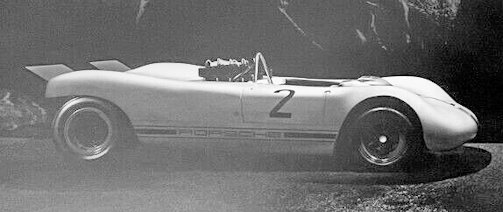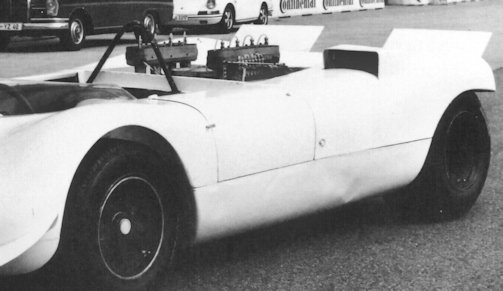Porsche 909 Bergspyder Race Car
 |
|
|
Production period: |
1968 |
|
Class : |
race car |
|
Body versions : |
monoposto |
|
Engines: |
Gasoline :2.0 Liters |
|
Length: |
3448 mm |
|
Width: |
1800 mm |
|
Height: |
710 mm |
|
Wheelbase : |
2264 mm |
|
Curb weight : |
430 kg |
|
previous model |
Porsche 910 |
The Porsche 909 Bergspyder was a race car of the Porsche KG , which was developed in 1968 specifically for the European mountain championship .
History
The car was intended for the 1969 European Hill Climb Championship. The 1981 cc flat-eight engine developed 275 bhp at 9000 rpm and the car weighed only 81/2 cwt. With the very light car Porsche pursued the goal to win after 1966 and 1967 for the third time in a row the championship title.
The 909 Bergspyder was only used in two races. Nevertheless, Porsche reached the finish and could celebrate with Gerhard Mitter , who drove in the race a Porsche 910 Bergspyder , the overall mountain championship victory in 1968.
Porsche began under the leadership of then development director Ferdinand Piech with the development of the 909, as the Porsche used last year was very difficult to drive 910 Bergspyder through constant modifications and the main rival Ferrari for the European Hill Climb Championship racing season 1968 had announced a new race car .
In the 909 Bergspyder, Porsche built an air-cooled, eight-cylinder boxer engine with a 2 Liter 771 displacement. This engine was used 910 Bergspyder already in the Porsche and tested under racing conditions. In the 909, the engine produced a maximum of 202 kW (275 hp) at 9000 rpm and thus about 3.7 kW (5 hp ) more than in the 910. This power increase resulted from the increase of the speed limit by 200 rpm and an increase in the compression ratio of 10.4: 1 to 10.5: 1.

Performance:
- maximum speed:250 km / h
- Power at 1 / min: 202 kW (275 hp) at 9000
- Max. Torque at 1 / min: 202 Nm at 7100
As a gasoline storage and supply Porsche used a lightweight 15-liter pressure accumulator made of titanium for weight reasons . Inside, the titanium ball tank contained a rubber bladder that was pressurized to 10 bars before launch and fuelled the fuel system during the race. In practice, the accumulator proved not optimal for use with the engine as well.
With the five-speed manual, the race car reached a top speed of about 250 km / h. In order to prevent one-sided by turning on the rear wheels, a multi-plate was limited slip differential installed.
The body of the 909 was similar in construction largely to the 910 Bergspyder. It was made of plastic and bolted to the lightweight aluminium grid frame. The open cockpit was designed two seats, and accessible via two small doors on the left and right side of the vehicle.
The bow and the stern could each be removed as a complete unit from the tubular frame. The bow had left and right two small discs to increase the air pressure during the ride on the front axle. At the rear were at the upper outer edges of two movable flaps, which were controlled by the Radfederung.
The engine was placed far in the middle of the vehicle and the transmission was installed in front of the rear axle between the engine and the limited slip differential in order to achieve as neutral a driving behaviour as possible. Due to the engine arrangement, the driver's seat had to be mounted almost above the front axle.
Due to consistent lightweight designed bodywork and vehicle components 909 Bergspyder with 430 kg was empty weight (375 kg dry weight ) extremely light. To achieve this, the developers implemented partially unusual materials and techniques. Thus, no conventional fuel tank with gasoline pump , but a very light 15 Liter petrol pressure accumulator made of titanium was used. The resistors for the ignition were on light balsa wood.
The racing car had an independent suspension with wishbones front and rear front and longitudinal push rods rear. Coil springs with hydraulic telescopic shock absorbers were used all around as vehicle suspension. The front springs were made of titanium. The brake system worked hydraulically. The brake discs were available in two versions. Apart from brake disks made of gray cast iron, those made of the very light beryllium were also used. Since the beryllium brake disks were very expensive to produce, only one vehicle was equipped with it.
For the transmission of power on the road provided wide wheels on the two axes. The 13-inch alloy cast wheels were 8 inches at the front and 13 inches at the rear. Then tires in the dimensions 4.75 / 10.00-13 front and 6.00 / 12.00-13 rear were mounted.
With the 909 Bergspyder, Porsche started in 1968 in the racing car class of the European Mountain Championships. Because of the short development time, the car could hardly be tested. The two Porsche works driver Gerhard Mitter and Rolf Stommelen drove in the training of the two-mountain race on Gaisberg (8 September) and on Mont Ventoux (September 22) the new Bergspyder. While Mitter decided for the older, but proven Porsche 910 Bergspyder, Stommelen started with the 909th.
In both races won the eventual championship winner Gerhard Mitter. Rolf Stommelen came in third due to engine problems on the Gaisberg and second on Mont Ventoux.
After the two races, the Porsche 909 Bergspyder was no longer used. However, it later served as a model for the development of the Porsche 908/03 .
Of the Porsche 909 only a total of two vehicles were produced.
Technical
-
Porsche 909 Bergspyder Technical details and specifications (1968)
CHASSIS BODY:
open plastic body with aluminum lattice frameENGINE:
8-cylinder boxer engine (four-stroke)
displacement: 1991 cm³
Bore × stroke: 76.0 × 54.6 mm
Compression: 10.5: 1
Valve control: two overhead camshafts each, vertical shaft drive
Cooling: Air cooling (blower)TRANSMISSION DRIVE LINE:
rear wheel drive
5-speed gearbox
limited slip differentialBRAKES:
Dual-circuit disc brakesSUSPENSION:
Front suspension: individually on double wishbones with longitudinal tension strutsCoil springs with hydraulic telescopic shock absorbers
Rear suspension: individually on double wishbones with longitudinal push rods Coil springs with hydraulic telescopic shock absorbers.DIMENSIONS AND WEIGHT:
Wheelbase : 2264 mm
Length: 3448mm
Width: 1800 mm
Height: 710 mm
Curb weight :430 kg
Track front / rear:1470/1464 mmWHEELS TYRES:
VA: 4.75 / 10.00-13 on 8J × 13
HA: 6.00 / 12.00-13 on 12J × 13
